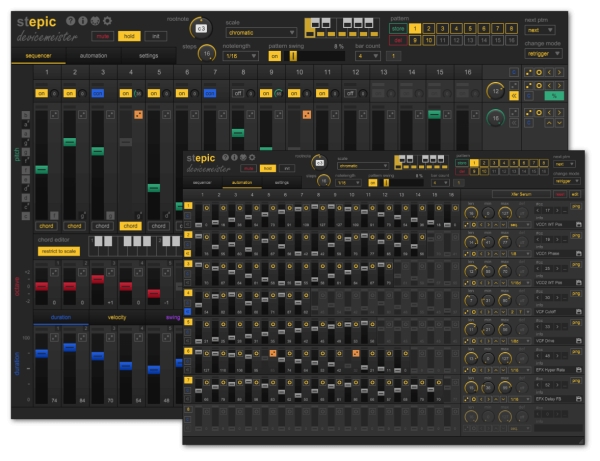🎹 Stepic: The Polyphonic Step & Modulation Sequencer Revolution
In a world of static piano rolls and linear MIDI lanes, Stepic by Devicemeister emerges as a dynamic powerhouse—a plugin designed to spark creativity and break mundane patterns. Whether you're programming intricate arpeggios, evolving rhythmic textures, or automating filter sweeps in complex polyrhythms, Stepic stands out as one of the most ambitious sequencers to hit VST3/AU formats in years.
Today, we’ll explore what Stepic is, how it works, its standout features, and why it’s become a favorite tool for producers across DAWs.
🧩 What is Stepic?
At its core, Stepic is a 16‑step polyphonic step sequencer enhanced by eight integrated modulation lanes. Each modulation sequencer can automate any MIDI‑controllable parameter in your plugins or hardware—think filter cutoff, wavetable position, effect levels, and more—via MIDI CC messages. This combination allows it to act not just as a note sequencer, but as a full-fledged motion-design engine.
Available as both VST3/AU for Mac and Windows and as a Max for Live device for Ableton Live (dubbed Stepic for Live), it's a flexible tool adaptable to any workflow.
🌟 Key Features at a Glance
🎼 1. Full‑Blown Pattern System
-
Up to 16 patterns, each up to 16 bars long, and chained together for sequences up to 4,096 steps
-
Pattern chaining options include Same, Next, Random, and Fixed, which encourage unpredictable and evolving textures
🎶 2. Per‑Section Sequence Control
-
Each section—Pitch, Octave, Duration, Velocity, Step‑Swing, Note‑Divider, Chord—and every modulation sequencer lane has its sequence length. This permits shifting polyrhythmic landscapes and evolving progressions, rather than rigid loop repetition.
🎧 3. Chord & Polyphony Engine
-
Polyphonic sequencer with per‑step chord editor spanning six octaves—you can define full chords per step, not just monophonic triggers
-
Chord‑tying feature ensures chord tones remain within your selected scale
🎲 4. Probability, Repeat, Dice & Randomization
-
Control the probability that notes play (Note‑On/Off), and add note repeats for those trap‑style rolls or granular taps
-
Over 200 randomization functions: pitch, velocity, swing, duration, dividers—even modulation values
-
Quick Dice to instantly shuffle parameter values—ideal for resetting creativity
✂️ 5. Clipboard & Step Connect
-
Copy/paste sequences across lanes and patterns in two clicks
-
Step Connect merges multiple steps into extended durations, good for sustained notes or ties
🎼 6. Custom Scales, Root Notes & MIDI Export
-
Predefined scales or create your own; easily stay in key
-
Define a root note per pattern.
-
Drag‑and‑drop MIDI and CC directly into your DAW for further editing
🎛️ 7. 8 Modulation Lanes
-
Each lane can modulate any parameter via MIDI CC or DAW‑host automation.
-
Assign different stepping lengths for each lane to create evolving, non‑repeating modulations
🖥️ 8. High‑Quality UI & Integration
-
Fully scalable, clean UI inspired by its Max for Live heritage—easy to navigate and visually clear
-
Native Apple Silicon support and MIDI‑FX version for Logic Pro
🎵 Working with Stepic
Setting Up
In VST/AU hosts, insert Stepic on a MIDI track targeting your soft synth or hardware via MIDI out. In Ableton Live, use Stepic for Live as a MIDI effect above your instrument chain
Designing Sequences
-
Set up pitch and chord lanes for harmonic content.
-
Use velocity/swing lanes to define the groove.
-
Vary lane lengths (i.e., 7‑step pitch, 9‑step velocity) for evolving loops.
-
Save as patterns, link them via chaining or random modes—ideal for live jams and breaks.
Modulating Effects
-
Route modulation lanes to CC targets: Filter cutoff on #74, LFO rates, reverb send—all mapped via easy MIDI mapping or DAW learn.
-
Adjust tempo/length per lane for shifting modulation rhythms (e.g., 13‑step cutoff filter, 17‑step pan sweep).
Humanize with Randomization
-
Use dice function or draw randomization ranges: e.g., pitch ±1 semitone, velocity 70%-90%, duration random tweaks.
-
Add note‑repeat to individual steps for hi‑hat rolls, granular chops.
Export & Refine
-
Drag out MIDI+CC and fine‑tune in piano roll—now you have creative templates for layering.
-
Reuse patterns across projects or synths.
💡 Real‑User Feedback
Across forums, Stepic is praised for its creative muscle:
From KVR forum insights:
“...polyrhythmic parameter progressions. ...This is a playable instrument and should have a place in any electronic music jam session”
Reaper forum:
“Stepic is the one sequencer to rule them all for Ableton”
Despite occasional technical hitches—like step timing offset in Logic being fixed by syncing sample rate (reddit.com)—overall support from Devicemeister is highly rated
💰 Price & Editions
-
Stepic VST/AU (for non‑Live hosts): €39
-
Stepic for Live (Max for Live): €39
-
Bundle (VST/AU + Live): €49
Considering its depth, modulation power, and pattern control, the bundle is a bargain.
🎚️ Strengths & Room for Improvement
✅ Strengths
-
Modulation Mastery: Eight lanes with independent rhythm lengths = total control over movement.
-
Polyphony & Chords: Rare for sequencers, especially with per‑step chord editing.
-
Randomization Galore: Nearly endless variations at your fingertips.
-
Creative Pattern Flow: Chain, randomize, and morph patterns for evolving compositions.
-
DAW‑agnostic: Works across all major DAWs, plus hardware via MIDI.
-
Rapid Workflow: Clipboard, dice, UI scalability — fast and usable.
⚠️ Limitations
-
Learning Curve: Feature‑rich UI needs time to master.
-
Minor Sync Issues: Some users report timing drift depending on sample rate
-
DAW‑Specific Routing in Pro Tools: Requires wrappers or workarounds, as no native AAX version
🎯 Who’s Stepic For?
-
Creative producers want organic motion over static loops.
-
Live performers need instant polyrhythmic changes and automations.
-
Modulation lovers chasing evolving textures and rhythmic movement.
-
DAW explorers looking to augment Ableton, Logic, Cubase, Bitwig, Reaper, Studio One, and more.
If you're content with simple piano rolls, Stepic might feel overwhelming—but if you're craving creative control and unpredictable inspiration, it's a game‑changer.
🏁 Final Verdict
Devicemeister’s Stepic is one of the most complete and forward‑thinking sequencers to hit the plugin market. Its bold approach—polyphony, chords, eight modulation lanes, deep randomization, pattern chaining—makes it more than a MIDI tool; it's a compositional instrument.
-
Cost: Affordable (€39‑49) for the feature set.
-
Support: Regular updates, Apple Silicon ready, responsive team.
-
Workflow: Unique capabilities not easily matched in-house by DAWs.
-
Creativity: Ideal for producing evolving ambient textures, arps, rhythmic beds, or live jams.
Sure, the dense UI and occasional sync quirks may slow your head‑start. But once you internalize its workflow, Stepic becomes a central hub for motion and modulation—a playground where inspiration finds shape in polyrhythmic wonderlands.
For any producer or performer seeking to escape repetitive loops and embrace creative unpredictability, Stepic isn't just a plugin—it’s a new language in music production.
✅ TL;DR Summary
-
Stepic is a polyphonic 16‑step sequencer with per‑section lengths, chords, probability, repeat, and over 200 randomization options
-
Eight modulation lanes offer tempo‑independent MIDI‑CC control over plugin/hardware parameters
-
Save up to 16 pattern banks, chain them freely, drag‑drop MIDI/CC, use the clipboard, dice features
-
Compatible with major DAWs; specific bundles for VST/AU and Max for Live; pricing starts at €39
-
Ideal for producers who want creative, evolving sequences with complex modulation and performance capabilities.
➡️ If you’re ready to move beyond static MIDI lanes and inject motion into your tracks, Stepic should be the next tool you explore.



